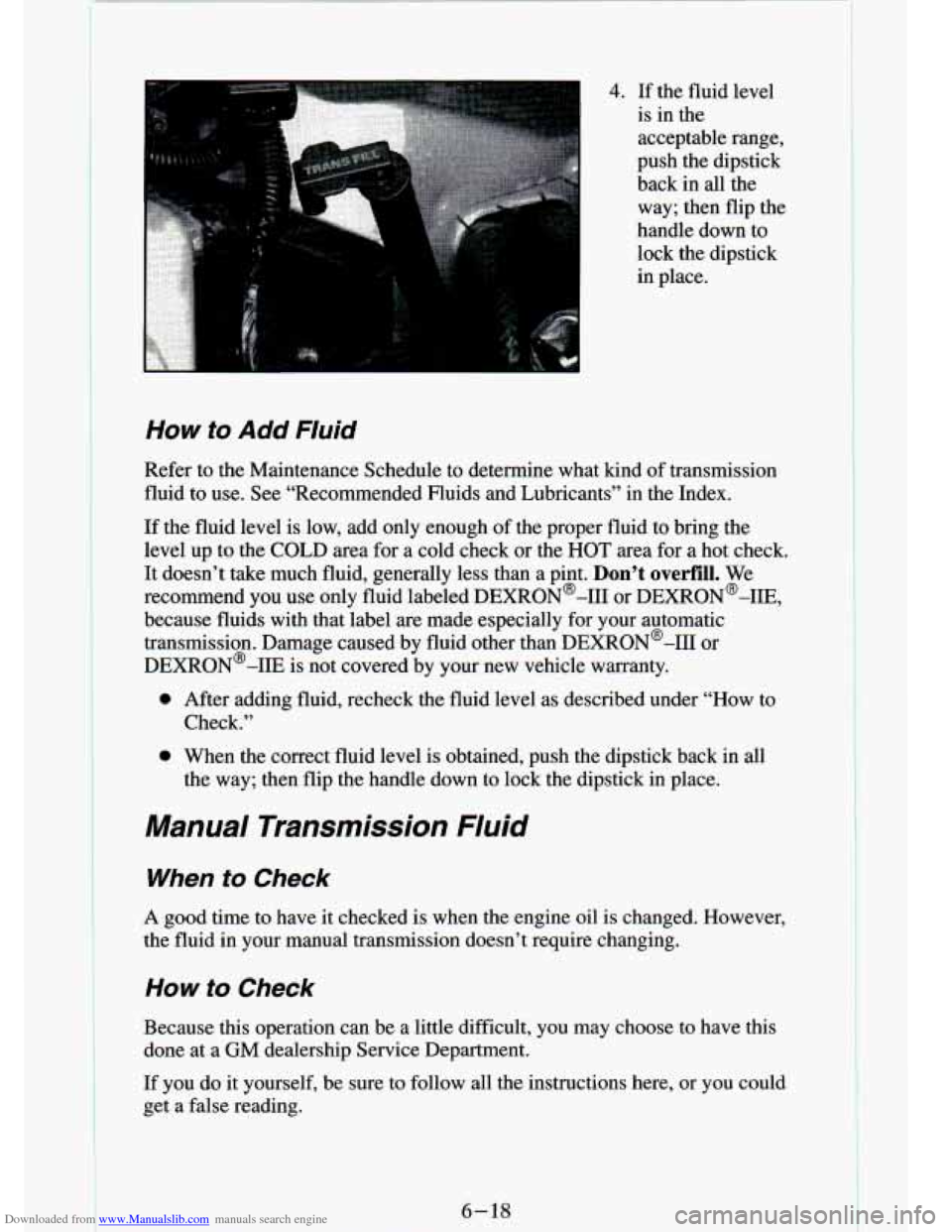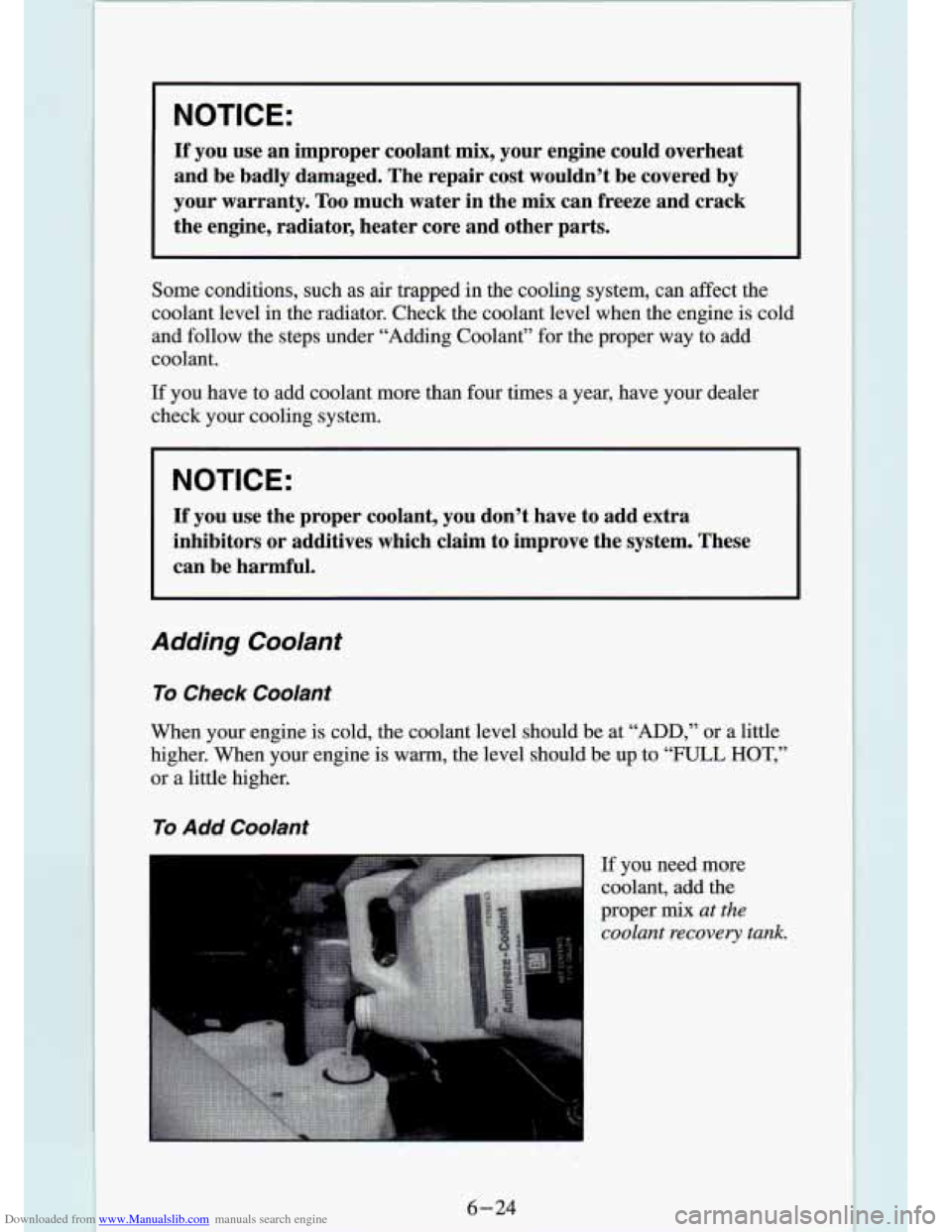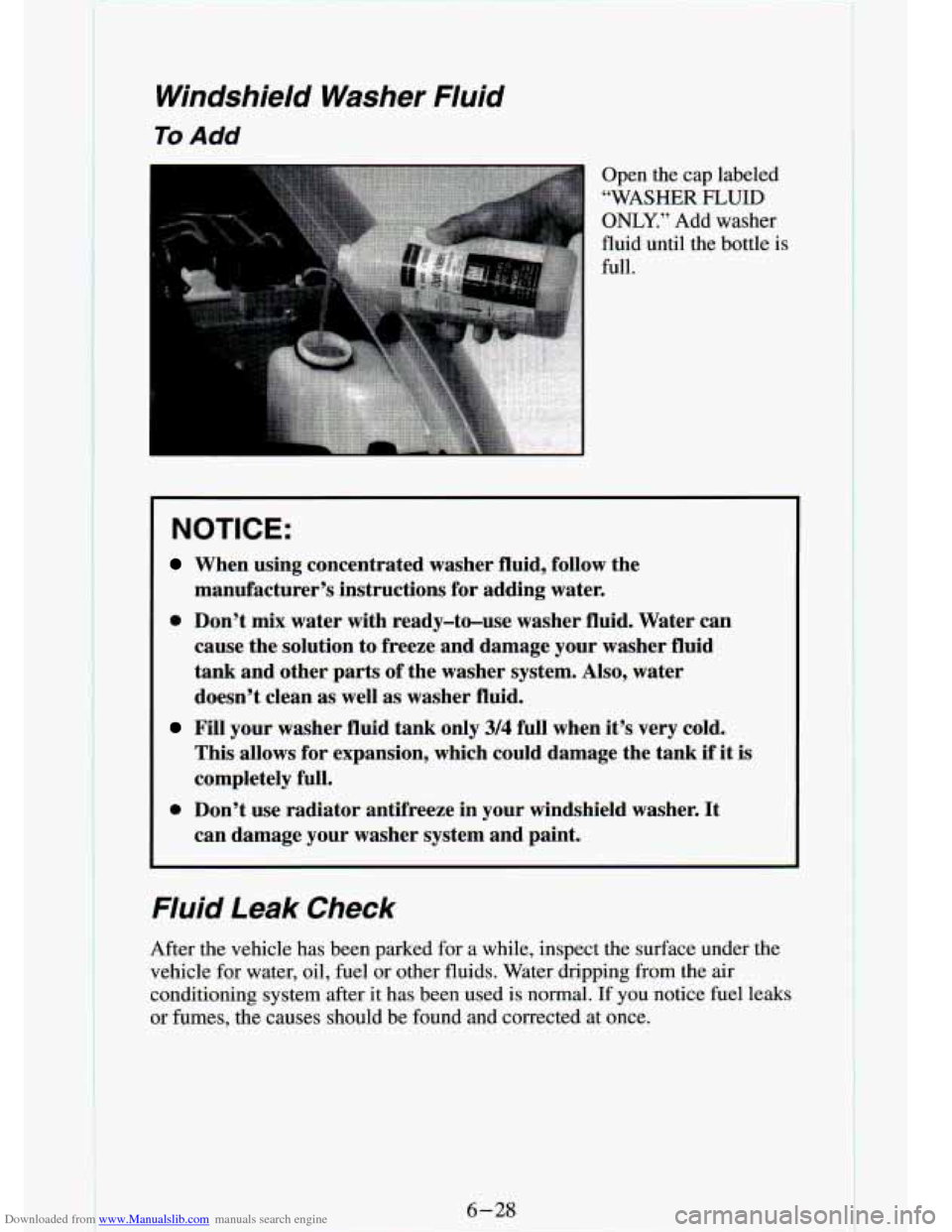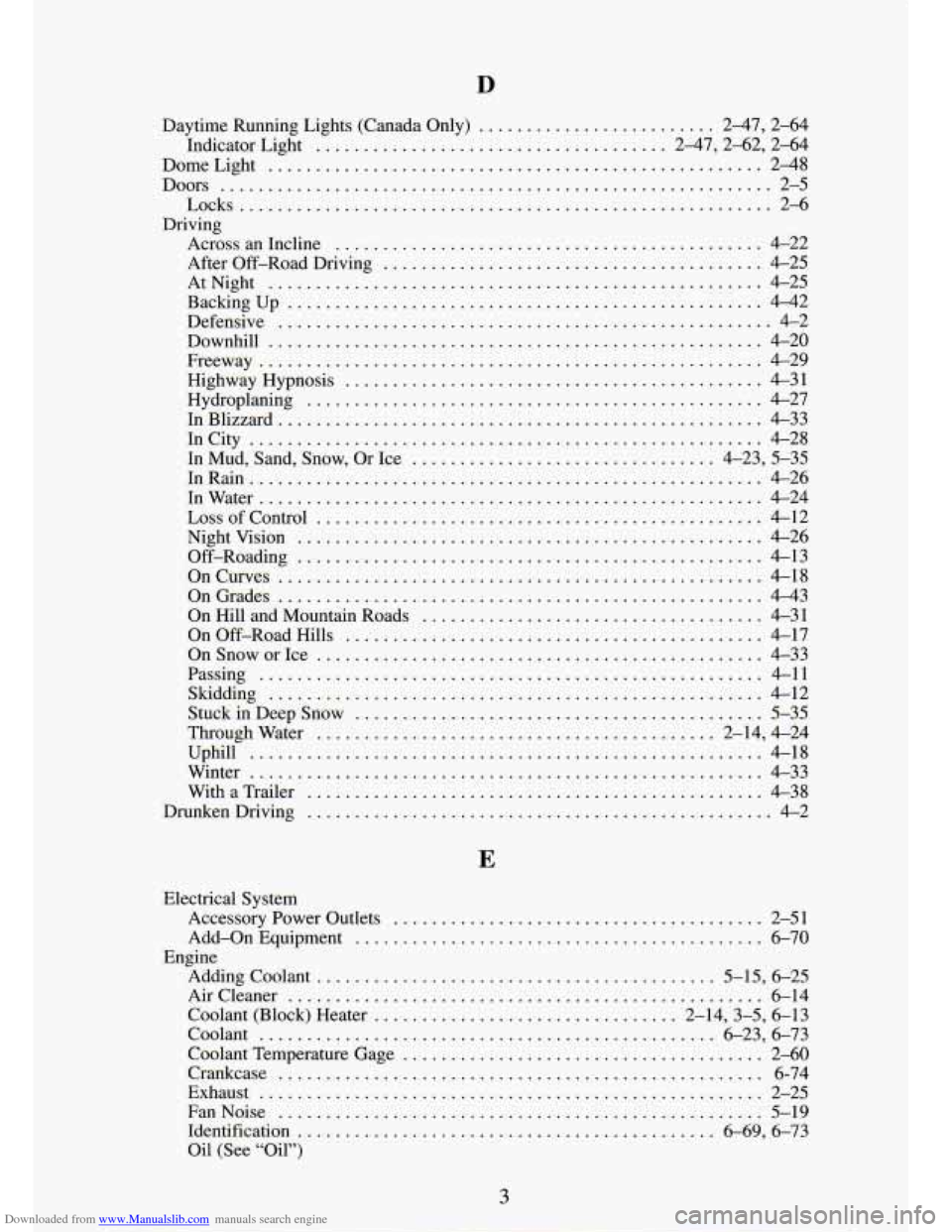adding oil CHEVROLET S10 1994 2.G Owners Manual
[x] Cancel search | Manufacturer: CHEVROLET, Model Year: 1994, Model line: S10, Model: CHEVROLET S10 1994 2.GPages: 340, PDF Size: 18.45 MB
Page 236 of 340

Downloaded from www.Manualslib.com manuals search engine 4. If the fluid level
is in the
acceptable range,
push the dipstick
back in all the
way; then flip the
handle down to
lock the dipstick
in place.
How to Add Fluid
Refer to the Maintenance Schedule to determine what kind of transmission
fluid to use. See “Recommended Fluids and Lubricants”
in the Index.
If the fluid level is low, add only enough of the proper fluid to bring the
level up to the COLD area for a cold check or the
HOT area for a hot check.
It doesn’t take much fluid, generally less than a pint.
Don’t overfill. We
recommend you use only fluid labeled DEXRON@-I11 or DEXRON@-IIE,
because fluids with that label are made especially for your automatic
transmission. Damage caused by fluid other than DEXRON@-I11 or
DEXR0N’-IIE is not covered by your new vehicle warranty.
0 After adding fluid, recheck the fluid level as described under “How to
Check.”
0 When the correct fluid level is obtained, push the dipstick ba\
ck in all
the way; then flip the handle down to lock the dipstick in place.
Manual Transmission Fluid
When to Check
A good time to have it checked is when the engine oil is changed. However,
the fluid in your manual transmission
doesn’t require changing.
How to Check
Because this operation can be a little difficult, you may choose to have this
done at a
GM dealership Service Department.
If you do it yourself, be sure to follow all the instructions\
here, or you could get a false reading.
6-18
Page 242 of 340

Downloaded from www.Manualslib.com manuals search engine I NOTICE:
If you use an improper coolant mix, your engine could overheat
and be badly damaged. The repair cost wouldn’t be covered by
your warranty. Too much water in the
mix can freeze and crack
the engine, radiator, heater core and other parts.
Some conditions, such as air trapped in the cooling system, ca\
n affect the
coolant level in the radiator. Check the coolant level when th\
e engine
is cold
and foilow the steps under “Adding Coolant” for the proper way to add
coolant.
If you have to add coolant more than four times a year, have your dealer
check your cooling system.
I NOTICE:
If you use the proper coolant, you don’t have to add extra
inhibitors or additives which claim to improve the system. These
can be harmful.
Adding Coolant
To Check Coolant
When your engine is cold, the coolant level should be at “ADD,” or a little
higher. When your engine is warm, the level should be up to
“FULL HOT,”
or a little higher.
To Add Coolant
I
If you need more
coolant, add the
proper
mix at the
coolant recovery tank.
6-24
Page 246 of 340

Downloaded from www.Manualslib.com manuals search engine Windshield Washer Fluid
To Add
I Open the cap labeled
“WASHER
FLUID
ONLY.” Add washer
fluid until the bottle
is
full.
NOTICE:
When using concentrated washer fluid, follow the
manufacturer’s instructions for adding water.
0 Don’t mix water with ready-to-use washer fluid. Water can
cause the solution
to freeze and damage your washer fluid
tank and other parts
of the washer system, AIso, water
doesn’t clean as well as washer fluid.
Fill your washer fluid tank only 3/4 full when it’s very cold.
This allows for expansion, which could damage the tank
if it is
completely full.
can damage your washer system and paint.
0 Don’t use radiator antifreeze in your windshield washer. It
Fluid Leak Check
After the vehicle has been parked for a while, inspect the su\
rface under the
vehicle for water, oil, fuel or other fluids. Water dripping from the air
conditioning system after it has been used is normal. If you notice fuel leaks
or fumes, the causes should be found and corrected at once.
6-28
Page 329 of 340

Downloaded from www.Manualslib.com manuals search engine Daytime Running Lights (Canada Only) ......................... 247. 2-64
Indicator Light
..................................... 2-47.2-62. 2-64
DomeLight
.................................................... 2-48
Doors
.......................................................... 2-5
Driving Locks
........................................................ 2-6
Across an Incline
............................................. 4-22
After Off-Road Driving
........................................ 4-25
AtNight
.................................................... 4-25
Backingup
.................................................. 4-42
Defensive
.................................................... 4-2
Downhill ...................................................... 4-20
Freeway
..................................................... 4-29
Highway Hypnosis
............................................ 4-31
Hydroplaning
................................................ 4-27
InBlizzard
................................................... 4-33
InCity
...................................................... 4-28
In Mud. Sand. Snow. Or Ice ................................ 4-23. 5-35
InRain
...................................................... 4-26
InWater
..................................................... 4-24
LossofControl
............................................... 4-12
Nightvision
................................................. 4-26
Off-Roading
................................................. 4-13
OnCurves
................................................... 4-18
OnGrades
................................................... 4-43
On Hill and Mountain Roads
.................................... 4-31
On Off-Road Hills
............................................ 4-17
OnSnoworIce
............................................... 4-33
Passing
..................................................... 4-11
Skidding
.................................................... 4-12
Stuck in Deep Snow
........................................... 5-35
Throughwater
.......................................... 2-14. 4-24
Uphill
...................................................... 4-18
Winter ...................................................... 4-33
WithaTrailer
................................................ 4-38
DrunkenDriving
................................................. 4-2
E
Electrical System Accessory Power Outlets
....................................... 2-51
Add-on Equipment
........................................... 6-70
Adding Coolant
.......................................... 5-15, 6-25
Aircleaner
.................................................. 6-14
Coolant (Block) Heater
................................ 2.14.3-5. 6.13
Coolant
................................................ 6.23. 6.73
Coolant Temperature Gage
...................................... 2-60
Crankcase
................................................... 6-74
Exhaust
..................................................... 2-25
FanNoise
................................................... 5-19
Identification
............................................ 6-69, 6-73
Oil (See “Oil”)
Engine
3